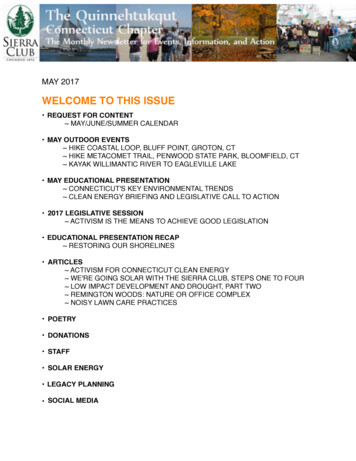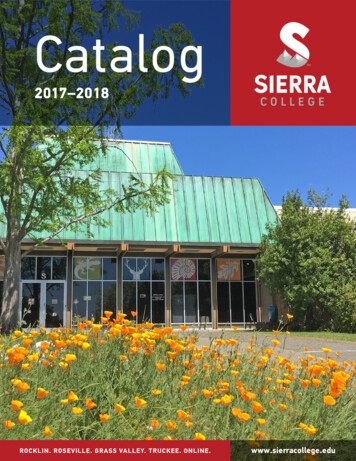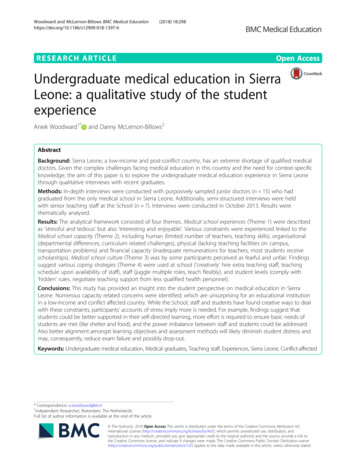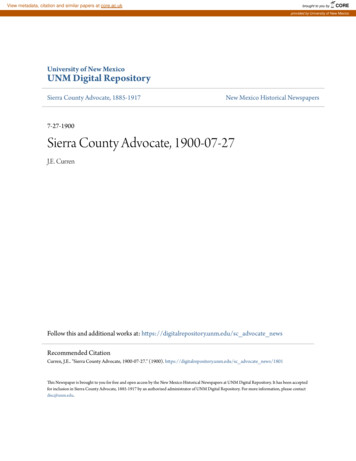
Transcription
MAY 2017WELCOME TO THIS ISSUE REQUEST FOR CONTENT MAY/JUNE/SUMMER CALENDAR MAY OUTDOOR EVENTS HIKE COASTAL LOOP, BLUFF POINT, GROTON, CT HIKE METACOMET TRAIL, PENWOOD STATE PARK, BLOOMFIELD, CT KAYAK WILLIMANTIC RIVER TO EAGLEVILLE LAKE MAY EDUCATIONAL PRESENTATION CONNECTICUT'S KEY ENVIRONMENTAL TRENDS CLEAN ENERGY BRIEFING AND LEGISLATIVE CALL TO ACTION 2017 LEGISLATIVE SESSION ACTIVISM IS THE MEANS TO ACHIEVE GOOD LEGISLATION EDUCATIONAL PRESENTATION RECAP RESTORING OUR SHORELINES ARTICLES ACTIVISM FOR CONNECTICUT CLEAN ENERGY WE'RE GOING SOLAR WITH THE SIERRA CLUB, STEPS ONE TO FOUR LOW IMPACT DEVELOPMENT AND DROUGHT, PART TWO REMINGTON WOODS: NATURE OR OFFICE COMPLEX NOISY LAWN CARE PRACTICES POETRY DONATIONS STAFF SOLAR ENERGY LEGACY PLANNING SOCIAL MEDIA
REQUEST FOR CONTENTAll Connecticut Sierra Club members are invited to contribute to the Quinnehtukqut. We acceptarticles, book reviews, puzzles, events, photos, poems, etc. Articles, limited to 500 words,should be on a subject of local or national interest to the Connecticut Chapter membership. Thegoal of the newsletter is to inform, educate, motivate and involve our members.If you post information to the website and want it in the newsletter as well, you must submitthose postings separately to the newsletter.We have developed a newsletter calendar for the next two 2017 submission dates whichincludes the Summer issue. The purpose of the calendar is to make it easier for you to plan yourQuinnehtukqut contributions for publication.The Quinnehtukqut is distributed at the beginning of the month. Comments, letters to the editorand all submissions may be sent to ctsierraq3@gmail.com for inclusion in future newsletters.MAY/JUNE CALENDAR:Saturday, May13th, JuneSubmissionsDueSaturday,June 3rdJune QDistributionSUMMER CALENDAR:Tuesday,May 30th,Summer IssueSubmissionsDueSaturday,July 1stSummer QDistributionAll decisions regarding use are made by the Communications Committee.
MAY OUTDOOR EVENTSHiking 1It's spring and hiking is back with a new leader, Geneva Renegar. Here are the details:Location: Bluff Point, Groton, CT778 acres of coastal preserve, the largest undevelopedcoastline in CT. Wooded trails, photo ops: wildflowers,panoramic views of Fisher Island, Little Gull Island andOrient Point from summit.Date: Saturday, May 6thTime: 10:00amLevel of Difficulty: Moderate, steady uphill ascent190 feet, followed by moderate descentLength: 3.6 mile Coastal Reserve loop trailFree event open to club members and the publicWeather: Light rain OK; heavy rain postpones toSunday, May 7thView from Coastal Reserve loop trailGPS Directions: Depot Road, Bluff Point State Park,Groton, CT 06340Written Directions: http://www.ct.gov/deep/cwp/view.asp?a 2716&q 325178&deepNav GID 1650#directionsFree ParkingSafety: All hikers must sign a liability waiver. You may review the waiver by clicking theattachment here:Sierra Club Outings WaiverDogs: Well behaved dogs on leash are permitted; bring bags to clean up after your dogs.Contact: Geneva Renegar, 860.857.2091; genevarenegar@gmail.comGeneva Renegar, a certified Chapter outings leader, is an avid hiker, walker and organicgardener who enjoys kayaking, hang gliding and observing nature. She believes in therestorative elixir of nature and hopes to inspire others to enjoy all the outdoors has to offer.
Hiking 2Celebrate the day before Mother’s Day with a beautiful hike in the woods. Meet our new leader,Christine Louden.Location: Penwood State Park, Bloomfield, CTWe will be hiking a loop that includes some of the Metacomet trail. The hike will take us throughforested areas, along a ridgeline and to a pond where we may be able to observe some earlyspring wildlife. The Metacomet Ridge is part of the New EnglandTrail (NET), which was designated in 2009 as a national scenic trail.Date: Saturday, May 13thTime: 10:00amLevel of Difficulty: Moderate, some up and down portions on apartially paved trail and a single track rocky trail.Length: 4-5 milesFree event open to club members and the publicWeather: Light rain OK, heavy rain postpones to Sunday, May 14thGPS Directions: 560 Simsbury Road, Bloomfield, CTNote: The entrance to Penwood is off Route 185 on the right if youare heading toward Simsbury from Bloomfield. There is a largeparking lot. We will meet at the trailhead near the parking lot.Free ParkingClothing: Please make sure you dress for the weather. Children arewelcome who are prepared for the distance and terrain.The Metacomet TrailDogs: Friendly, well behaved leashed dogs are welcome. Bring bagsto clean up after your dog.Safety: All hikers must sign a liability waiver. You may review the waiver by clicking theattachment here:Sierra Club Outings WaiverContact: christinelouden@att.net with the number in your party. If your plans change, please lether know so she has a proper head count. Cell: 860.280.6309Christine Louden, a certified Chapter outings leader, is looking forward to leading hikes inConnecticut to revisit some of her favorite places and discover new trails with other interestedpeople. She is an avid trail runner and has an interest in plant identification and edible andmedicinal plants that she hopes to share on hikes.
KayakingKayak on the Willimantic River and Eagleville LakeDate: Saturday, May 27thTime: NoonLocation: Mansfield, CTFree event open to club members and the publicDescription: Let’s begin our local paddling seasonwith a quiet water ramble down Willimantic River toEagleville Lake through lush woodlands and activebird areas with slow currents and good year roundwater levels.We can finish the trip by exploring wooded areasupstream past the put until the current gets too strong,then fall back to the launch.Map of the lakes: Click HereMeet: Mansfield River Park. Portage 100 feet from parkingto concrete ramp in sheltered bay.Directions: Route 84 to Route 44, south .3 miles onStafford Road, Route 32. Turn right onto Plains Road.River Park is .2 miles on right.GPS: If you enter 50 Plains Road, Mansfield, you’ll beclose.RSVP: Yes only by Friday, May 26th to Renee atmchawigirl@yahoo.com. Be sure your cell phone is onSaturday morning in case weather/winds require sitechange or canceling.Safety: Safety vests must be worn at all times.All attendees must sign a liability waiver. You may review the waiver by clicking the attachmenthere: Sierra Club Outings WaiverNo cell phone use or smoking on the water.Optional: Post paddle dining 10 minutes away overlooking Coventry Lake at LakeviewRestaurant, 50 Lake Street, Coventry, Connecticut.
MAY EDUCATIONAL EVENTSConnecticut's Key Environmental TrendsWhat’s better, what’s worse in the Connecticut environment and why?Hear the executive director of the state Council on EnvironmentalQuality (CEQ), Karl Wagener, discuss its recently-published report onConnecticut’s key environmental trends. He will also explain how theCEQ helps citizens with environmental problems.Speaker: Under the direction of Karl Wagener, the CEQ monitors thecondition of Connecticut’s air, water, land and life and recommendsimprovements to state laws and policies. Wagener is also involved withinvestigating and finding solutions to complaints from the public aboutKarl Wagener, CEQenvironmental problems. He oversees publication of the CEQ’s annualreport to the governor, Environmental Quality in Connecticut. Previouslyhe worked on environmental policy for the Connecticut Audubon Society and was its lobbyist atthe State Capitol.Sponsor: Greater Hartford Sierra ClubDate: Thursday, May 11thLocation: Westmoor Park Lodge, 119 Flagg Road, West HartfordTime: Activist letter writing: 7:00pm; Program: 7:30pmDonation: 4 to defray hall rental feeQuestions: Renee at mchawigirl@yahoo.com
Clean Energy Briefing AND Legislative Call To ActionA legislative briefing on the current energy and climate issues in Connecticut will be presentedby representatives of Farmington Indivisible, Connecticut Chapter Sierra Club, Clean WaterAction and Connecticut Fund for the Environment. Speakers will review current energylegislation and identify opportunities for clean energy breakthroughs — or defeats.Learn action tips and strategies to take legislative action on the issues. Use your new skills towrite a letter to your legislator or the news media on the spot.Date: Monday, May 15thTime: 7:30pmLocation: Amistad Hall, First Church Congregational, 75 Main Street, Farmington, ConnecticutUse School Street entry to reach lower level, rooms 101-102.Parking: Barney Library parking lot off Church StreetIssues Legal limits on local renewable energy projects and efforts toremove them The continuing threat of natural gas infrastructure expansion How Millstone’s nuclear power could be competitive with cleanrenewable energy What our statewide environmental organizations are doing Action opportunities for you this legislative session Tips for effective advocacy
2017 LEGISLATIVE SESSIONActivism is the Means to Achieve Good Legislationby Roberta ParoOver one hundred concerned Connecticut citizens attended our March 8th Lobby Day at theLegislative Office Building in Hartford. A number of state legislators stopped by to address us,and it was an honor to have so many politicians eager to speak to our group and to share theirexpectations for this legislative session!As the 2017 legislative session winds down, we are asking for your help with two bills that could1) expand the use of solar and wind in Connecticut and 2) create a path toward a transparentreview process for public lands proposed to be removed from state ownership.Expanding Connecticut’s Renewable Portfolio Standard (RPS) will help us reach our goal oflowering Connecticut’s greenhouse gas emissions 80 percent from our 2001 levels, by 2050while lowering wholesale energy costs, cleaning our air and creating jobs in Connecticut andNew England.We all realize, if we didn’t already, that political engagement is no longer optional. We need tomake sure our legislators know where our interests lie.Two Bills to Support or Oppose NowIn the remaining weeks of the 2017 Connecticut legislative session, two priority bills for theenvironment are winding through the legislature that need your advocacy. The bills are:Senate Bill (SB106): Oppose "The Millstone Bill"- This bill must be amended to removesubsidies for nuclear and waste incineration because they are dangerous and dirty,and increase the renewable portfolio standard for wind and solar to use for electricity generationin the state because they lower wholesale energy costs and create jobs in Connecticut and NewEngland. The Sierra Club opposes this bill as it is now written. atus.asp?selBillType Bill&which year 2017&bill num 106Senate Joint Resolution (SJ39): Support "Protect Open Space Bill"- to amend the stateconstitution to protect state lands. A transparent review process is necessary to ensure that anyproposal to remove lands from state ownership is in the public interest. The amendment willhelp Connecticut reach our goal of setting aside 21 percent of our land into protected openspace. The amendment is expected to help restore public trust so individuals will be confidentbequeathing private land to the state. atus.asp?selBillType Bill&which year 2017&bill num SJ39How Can You Help?Call your State Representative and State SenatorFind your legislators Click Here. Identify yourself as a constituent and a Sierra Club memberand let them know what you want. Legislators want to hear from their constituents.
Volunteer. Participate in one or more Wednesday lobbying efforts between now and June 7th atthe state capitol in Hartford to protect open space and help achieve the outcomes we need toprotect our land, air and climate.Contact:Chapter Program Manager, John lub.orgThank you from the CT Chapter Sierra Club Legislative Team!Roberta Paro, former Chair of Connecticut Chapter Sierra Club is now Co-Chair of theLegislative CommitteeEDUCATIONAL PRESENTATION RECAPRestoring Our Shorelinesby Stephanie Beals"The poetry of the Earth is never dead." John Keats'Living Shorelines' are man-made coastal protection structures that attempt to mimic naturebased erosion control. New to Connecticut and the Northeast, these structures may be a way ofpreserving natural shore elements while protecting our shorelines from erosion.The Connecticut Institute for Resilience & Climate Adaptation (CIRCA) studies the resilienceand sustainability of vulnerable communities in Connecticut to severe storms and the growingimpact of climate change. The 'Living Shorelines' technique is new and CIRCA is working toraise public awareness.By tracking tide gauges since the 1800s, andstudying satellite records, assessing rising carbonlevels and polar ice melt, science has speculatedthat sea level rise can cause approximately 200additional flood events in Connecticut by 2050. Sixhundred additional events per year could bepossible by the end of the century.CIRCA has been involved with providing grantmoney and information to build living shorelinesacross the Connecticut coast, using variousmaterials such as oyster and coral reefs,breakwaters and groins, all to help facilitate beachand dune restoration. These barriers act to slowwaves and absorb flooding from storm surges.Access CIRCA at:http://circa.uconn.edu/living-shorelines/Reef balls, made of cement, at Stratford Point in Stratford,Connecticut, currently attempting to protect 750 feet ofshore, by mimicking a natural oyster reef.Photo: Jan Ellen Spiegel, The CT MirrorDr. Rebecca French, professor of Geoscience at CIRCA delivered the presentation on "LivingShorelines: Practices and Projects in Connecticut" at the Greater Hartford Sierra Club meeting,
April 13, 2017. CIRCA offers workshops open to the public. Dr. French may be contacted atRebecca.french@uconn.edu.Note: The Sierra Club approves shoreline restoration efforts on a case by case basis.Stephanie Beals is a freelance writer, editor, environmental advocate and volunteer with theGreater Hartford Group, CT Chapter Sierra ClubARTICLESActivism For Connecticut Clean Energyby James RootIn the face of a difficult national political situation, Connecticut clean energy activism continuesapace, with fighting on several fronts.Lobbying Senators Murphy and Blumenthal, Connecticut Chapter Sierra Club and 350 CTcontinue to ask our Senators to reconsider their heretofore supportive view of the interstatepipelines. Here's why.Gas Pipeline ExpansionThe Algonquin interstate methane (naturalgas) pipeline runs through 320 miles ofConnecticut, as well as in Massachusetts,New York and Rhode Island.Expansion 1 ‘AIM,’ is complete.Expansion 2 The Algonquin, ‘Atlantic Bridge,’was approved by the Federal Energy andRegulatory Commission (FERC) and is soonto be built.Expansion 3 Owners of ‘Access Northeast,’Algonquin, have delayed the FERC approvalprocess, while they seek funding for theunneeded project.Photo: H John Voorhees III / Hearst Connecticut MediaActivism at WorkWhen the Connecticut Department of Energy and Environmental Protection (DEEP) rejected theEnbridge, Eversource and National Grid proposal for Access Northeast last year, due in part toresistance from Connecticut ratepayers to paying for that multi-billion dollar expansion, itcontributed to the challenge the owners faced in funding it.Massachusetts and Connecticut residents continue to attempt to slow down the smaller butsignificant Kinder Morgan Connecticut Expansion interstate pipeline project on the Connecticut/Massachusetts border.
Activists Work to Slow ActivityComing down to the critical and more tangible state level, activists, led by the ConnecticutChapter Sierra Club, continue trying to slow the creation of what is becoming the interstatepipeline’s biggest customer: methane power plants. The ‘NTE’ gas power plant proposal inKillingly is the scene of a continuing contest between developers and local residents. BothSierra Club and Connecticut Fund for the Environment (CFE) legally intervened against thisplant. In addition, local and state-wide opposition is engaged in protesting the air pollution andAcid Rain permits approved by DEEP for the Oxford methane power plant (currently underconstruction).At the same time, activists are busy lobbying DEEP at hearings and in writing to deny statepermits for projects such as the Oxford and Chaplin compressor stations, part of the AtlanticBridge expansion. Compressor station enlargements are necessary to push greater quantities ofgas along the line. Atlantic Bridge is still facing many challenges, including legal interventionsconcerning conflict of interest, filed by a number of groups including Food and Water Watch.Strategies on MethaneFood and Water Watch, spearheaded inConnecticut by local organizer JenSiskind, has approached the methaneissue very strategically and successfully,overseeing the passage of fracking wastebans in 13 Connecticut towns and cities.This effort has the potential to ‘cut thesnake off at its head’ as frackers west ofus in Pennsylvania need somewhere toput the liquid and solid waste created bytheir operations.Finally, in a less reactive and moreforward looking fashion, energyactivists are: Engaged in pushing Connecticut state legislators to pass clean energy legislation in thecurrent legislative session with only little over a month to go Fighting the attempt to provide the already profitable Millstone nuclear power plant inWaterford with more subsidies Pushing the state to require that energy distributors Eversource and UI buy increasingamounts of renewable energyStatewide Bills on the EnvironmentA host of other bills, including a statewide effort on fracking waste, have occupied the attentionof many state activist groups, including the legislatively focused Connecticut League ofConservation Voters and Connecticut Fund for the Environment. The Connecticut Climate andJobs Roundtable, led by John Humphries, continues its broad array efforts including aprominent lobbying position on the state’s long term climate planning group, the Governor’sCouncil on Climate Change or ‘GC3.’
Despite the national political scene or how disappointing and discouraging to renewable energyactivists last November’s election results appear, they do at least force Connecticut residents tolook harder for opportunities to shape our energy future on the state level. This approach mayprovide the most political leverage and be the most feasible.James Root is a Sierra Club Member and Danbury ResidentWe're Going Solar with the Sierra Club: The Decisionby Eileen MonaghanHere's the house--with a new roof, right! It's a classic 1977 ranch of 1600 square feet. That longfull length section of the house facing you, also faces south, the best direction! Yeah! No trees,right! Let's cut our heating bill and diminish our propane use. Better for the environment, betterfor us!Step One: Select the Solar CompanyAs proud members of CT Chapter Sierra Club, we calledSungevity and the competition. Guess what? Sungevity hadthe better price plus they donated 750 to the Sierra Clubwhen we signed the contract. We decided on a 20-yearlease of the solar panels rather than a purchase plan.Step Two: The EvaluationPainlessly, by computer with a live person guiding the effort,we filled out all the paperwork. Next, an estimator came tothe house to check roof stability and attic support strength.He also measured the roof and evaluated the electricalsystem in the house.Long south sided roof, perfect for solarpanelsBased on the estimator's data collection, Sungevityengineers determined the number and placement of the solarpanels and all the attended electrical apparatus. The results: the number of solar panelsrequired is 33 panels, all the same size, configured for the south side of the house.We learned that the number of solar panels is determined by the average monthly electricaldemand based on the most recent year's electrical use. Sungevity cannot install a system thatgenerates more electricity in a month than we are expected to use. If, however, we do generatemore electricity than we use, the utility will purchase the extra energy at the wholesale rate.Step Three: Home Energy AuditTen days later three men arrived to evaluate the interior of the house and make any interiorchanges that could help insulate the house. The cost: 124 outlay, reimbursed to us bySungevity. Here's what they did: Tested how well the house is sealed using a special seal testing fan and gauge Changed all light bulbs to LEDs throughout the house; 25 LEDs and eight specialty LEDs Installed new fixtures tight to the ceiling Pulled back attic floor insulation and sprayed in foam sealant Sealed every opening in our cement foundation and in the house
Offered a 75 rebate on a Nest thermostat, if we choose toreplace the current thermostat Added an insulated zipper blanket over the attic stairs to sealthat location. The additional cost of 210 was our choiceStep Four: PermittingNow our local town hall has to issue a building permit for thesolar panels to be installed. It usually takes five weeks toreceive the permit.Step Five: Installation will be an article in a future issue,probably the Summer Quinnehtukqut.Seal testing fan and gauge inhome's front hallwayEileen Monaghan is a CT Chapter Sierra Club member,founder and president of The Wedding Council and copresident of the Merryall Center for the Arts.Low Impact Development (LID) and Drought, Part Twoby Nora HultonAs the state of Connecticut becomes more developed the amount of impervious surface in theform of pavement, cement or asphalt roof shingles increases. When rain hits these surfaces itruns off at a rapid rate and usually re-enters a water body, via storm drains, carrying with it anypollutants it has picked up along the way. This is a “lose lose” situation, as local water bodiesbecome contaminated and precious rain water doesn’t get the chance to infiltrate the soil andrecharge our groundwater supplies.Storm Water Pollution“Stormwater pollution is ranked as the number one cause of degradation of our rivers, lakes andstreams .current practices of stormwater management for land development have manyadverse impacts on the natural environment such as water quality impairment and degradationof our streams and groundwater depletion," explained Sean Hayden, soil scientist and executivedirector of The Northwest Conservation District, based in Torrington. He reports that "currentcodes often mandate extensive land clearing that destroys existing on-site vegetation andhydrology.” He also stresses the urgent need to increase our permeable surface with thesesobering statistics, “On an undisturbed vegetated site ninety percent of a one inch rainfall willinfiltrate into the soils with only ten percent becoming runoff. When a site is developed in thetraditional manner, this relationship reverses to only ten percent infiltrating and ninety percentbecoming runoff (Hayden).”With the increase of impermeable surface annually in our state, it’s becoming apparent thatpreventive and adaptive strategies have to be implemented to conserve our invaluable liquidresource. There are many effective Low Impact Development (LID) practices, and they canrange from fairly easy, do-it-yourself methods to intricately engineered projects. Two of the lessdaunting, yet very efficient and attainable approaches are rain barrels and rain gardens. These
techniques are easy to implement, and the average homeowner can make a significantcontribution to improving the quality of local waterways and drinking water.Rain BarrelsToday’s rain barrels are not made of wooden staves and cinched with metal bands like the watercasks of yore. Presently, attractive, streamlined plastic vessels with bottom spouts that can beconnected to garden hoses are the storage tank of choice. Using them, however, is still assimple as it was in your grandmother’s day. Place it directly under your downspout and standback and watch as the magic happens. The CT DEEP reports that 50 gallons of rainwater canbe collected after just a ¼ inch of rainfall; multiply that by three barrels per household in aneighborhood of 100 houses, and you’ve saved over 15,000 gallons of storm water. That’senough water to keep the average water sprinkler pumping for over 62 hours (A Resident’sGuide to Rain Barrels).Rain GardensRain gardens are another easy way to take a bite out of storm water runoff. This method worksby diverting rainwater from downspouts and impervious surfaces such as: driveways, sidewalks,and patios into a vegetated depression. Deep-rooted native plants that can tolerate temporary“wet feet” are planted in the shallow basin. The vegetation, coupled with a well-draining soil,work to purify the captured storm water as it trickles down from the soil surface through thesubterranean layers. The impurities from fertilizers, pesticides and other household wastes arefiltered out before the reclaimed resource is introduced into local surface or groundwatersupplies. Rain gardens areaesthetically pleasing, and the nativeflora also provides the additionaladvantage of attracting beneficialbirds and insects to your yard (AResident’s Guide to Rain Gardens).Sufficient rainfall cannot be the onlysolution to the water shortage causedby extended drought; the capture andconversion of storm water back to aclean, usable resource is of equalimportance. It’s imperative that LowImpact Development strategies areA Newly Planted Connecticut Rain Gardenmainstreamed and widelyPhoto credit: UConn Tolland County Extension Center, Vernon,implemented before the issue ofCT.clean water availability takes a criticalturn. To learn more about howproductive LID measures can be enacted on a state, municipal, and even a private level go toLearn MoreWorks CitedHayden, Sean. "LID and Drought," e-mail interview, 10 February, 2017Rainfall as a Resource: A Resident's Guide to Rain Barrels in Connecticut and A Resident'sGuide to Rain Gardens in Connecticut, Hartford, CT Connecticut Department of Energy andEnvironmental Protection, 2009. Print.Nora Hulton is a Connecticut Certified Wildlife Conservationist and a member of the CT ChapterSierra Club.
Remington Woods: Nature or Office Complexby Peter McKnightRemington Woods, a 422 acre parcel of land with 344 acres in Bridgeport and 78 acres inStratford, is under threat. In a region that has little natural space, this privately owned land is thelast remaining undeveloped site in Fairfield County and one of the largest unprotected urbanopen spaces in the northeast.With its 25 acre Lake Success at thecenter of the property, the remainingopen space is home to swans, snakes,other wildlife and many inlandwetlands. See a list of wildlife in theWoods at: Wildlife. The site has beencalled a hidden natural paradiseteeming with life and nearly untouchedby man for decades.23 acre Lake Success in Remington WoodsRemington Woods' history is not sonatural. Remington Arms Corporationused it as a testing ground for theirweapons in the 1920s and 1930s. As aresult, the forest was off limits for mostof the twentieth century as it housedpotentially explosive material.The Site TodayThough much of the site is not polluted, Remington Woods is designated a "brownfield" whichDuPont, the current owner, is remediating to meet "industrial standards."The site is difficult to approach. There is no access for the publicexcept for the occasional bus tour provided by DuPont, or thelimited vistas into the site from the other side of the fence. Somepropose federal funds be used to build a major road to provideaccess from the Bridgeport side if the property is developed as anoffice complex. Although there are scattered city sites whereeconomic development is also feasible, there is no large openspace that can provide a major natural tourist attraction withhiking trails, an undisturbed ecosystem from colonial times,wildlife and vernal pools and camping. The possibilities areendless for this rare natural space within the city of Bridgeport.See videos of the site at: Video of Siteor Friends of Remington WoodsActivism: The 2017 Way to FightIs it really a wise investment to immediately destroy a naturalspace, or should efforts be made to find ways to allow that naturalspace to add value to the local community? Friends of RemingtonWoods propose to protect the land as open space or as a greenAerial view of Remington Woods andSuccess Lake
development to attract tourism. We have to get the message out.On April 6th, students at Housatonic Community College were amazed to learn from membersof the Eastern Fairfield County Sierra Group about the hidden 422 acre natural parcel they didnot know existed in their city. Great interest was generated as students signed a petition to saveRemington Woods and promised to attend the City Council meeting on April 17th in support ofsaving this hidden gem. The Woods are hidden from most residents behind buildings and otherstructures. The aerial picture of the property is a surprise to many.What You Can Do1. Sign the petition! Add your name to the growing list of people who do not want to see Remington Woods destroyed.2. Attend all Bridgeport/Stratford City Council meetings where Remington Woods is discussed. Check future event info at the link -152076305887/3. Contact the people involved and tell them you donot support industrial development. Say you want tosee this community asset used to preserve the natural space. Ask them to support preservation of Remington Woods and to resist calls for development.Note: Telephone messages have the most impact,but you can telephone and/or email.ContactsBridgeport Mayor Joseph GanimPhone: 203.576.7201Email: mayor@bridgeportct.govBridgeport City Cou
protect our land, air and climate. Contact: Chapter Program Manager, John Calandrelli 860.236.4405 connecticut.chapter@sierraclub.org Thank you from the CT Chapter Sierra Club Legislative Team! Roberta Paro, former Chair of Connecticut Chapter Sierra Club is now Co-Chair of the Legislative Committee EDUCATIONAL PRESENTATION RECAP










